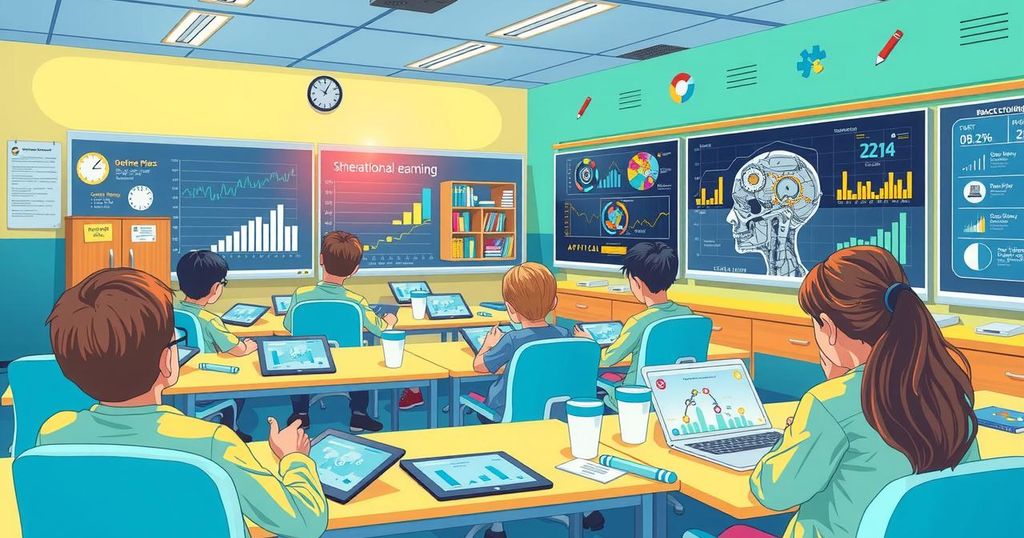AI
IT
ACADEMY, ARTIFICIAL INTELLIGENCE, COMPUTER SCIENCE, EDUCATION, ELIZABETH, ENVIRONMENTAL SUSTAINABILITY, MEG, MEGHAN GROOME, NEW JERSEY, NEW YORK ACADEMY OF SCIENCES, NEW YORK ACADEMY OF SCIENCES ’ SCIENTIST - IN - RESIDENCE, NEW YORK CITY, NORTH AMERICA, NYC, NYC DEPARTMENT OF EDUCATION, SCIENCE_TECHNOLOGY, SIR, STEM EDUCATION, UNITED STATES
Liam Kavanagh
0 Comments
Transforming STEM Education: NYC Teachers Embrace AI Tools in Classrooms
New York City teachers are using AI in STEM education through the Scientist-in-Residence program, enhancing student engagement with hands-on, inquiry-based projects. This initiative, supported by the New York Academy of Sciences, is breaking new ground with innovative tools and ethical considerations shaping how science is taught in classrooms across five boroughs.
In an exciting shift for STEM education, teachers in New York City are harnessing artificial intelligence (AI) to breathe new life into science classes. The New York Academy of Sciences is at the forefront of this initiative, which aims to enhance student engagement and understanding. The Academy’s Scientist-in-Residence (SiR) program, launched in 2012, pairs STEM professionals with public school educators to create hands-on, inquiry-based learning projects.
For the 2024-2025 academic year, the program is set to reach 50 classrooms in New York City, plus five in Elizabeth, New Jersey. With an impressive statistic—80% of these schools are Title I—the SiR initiative covers a diverse range of subjects from biology to computer science. Teachers and their scientific partners are actively reshaping how students experience and learn science, opening doors to innovative teaching methods.
This year, thanks to pilot funding, the Academy has embarked on a bold endeavor, introducing GenAI tools to elevate classroom projects. Unique workshops and expert coaching have been provided, allowing teachers to integrate AI alongside their existing curricula. Here, AI isn’t merely about saving time with grading, it’s about deepening students’ learning experiences.
One standout feature of this approach is its focus on elevation rather than efficiency. Teachers are not trying to cut corners; rather, they’re diving deep into conceptual understanding. For example, in one physics class, students examined AI-generated simulations against real physical laws, sparking discussions about both scientific accuracy and technological boundaries.
Moreover, the power of peer-to-peer recommendations shines through. According to a working group of teachers, successful tools are shared and adopted across classrooms, driven by trust and collaboration. This grassroots ethos is a cornerstone of the program, promoting proven solutions among educators.
Alongside this, teachers are learning to advocate for access to these AI tools. With many requiring approval from school districts, sharing success stories and practical tips among colleagues can smooth the approval process. This knowledge is crucial as regulations surrounding AI in education continue to evolve.
Ethics also play a pivotal role in how educators evaluate AI tools. Teachers are looking through a lens of moral considerations concerning intellectual property, bias, and environmental impact. High school students often echo these concerns, prioritizing ethical implications over convenience, which is an encouraging trend.
When it comes to data, teachers are engaging with substantial datasets such as air quality information and robotic logs. They’re experimenting with AI-driven visualization tools like Tableau Public and Google Colab to make sense of the data, even if some tools present usability challenges in the school environment.
AI’s capabilities for image analysis are opening up even more doors. Educators are thrilled to utilize AI for tasks that traditionally took hours, like analyzing plant growth. Tools such as NASA’s platforms and Phyphox are revolutionizing the way that visual data can support scientific experiments.
As the Scientist-in-Residence program adapts and grows, it’s clear that NYC educators aren’t just preparing for the future—they’re actively shaping it. By embracing innovation, collaboration, and ethical uses of AI, they’re equipping their students for tomorrow’s challenges, fostering inspiration that could lead to the next generation of scientific pioneers.
NYC teachers are embracing AI to reshape STEM education significantly. Through the Scientist-in-Residence program, they’re not only introducing students to innovative tools but also fostering collaboration and ethical engagement. As these teachers pave the way for a more interactive learning approach, the impact of their efforts is likely to be felt for years to come, cultivating future scientists who value ethical considerations in their work.
Original Source: www.nyas.org




Post Comment